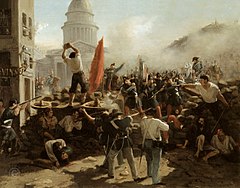Spring of nations

Barricade on the rue Soufflot, an 1848 painting by Horace Vernet. The Panthéon is shown in the background.
|
|
| Date | 23 February 1848 – early 1849 |
|---|---|
| Location | Western and Central Europe |
| Also known as | Spring of Nations, Springtime of the Peoples, Year of Revolution |
| Participants | People of France, the German states, the Austrian Empire, the Kingdom of Hungary, the Italian states, Denmark, Wallachia, Poland, and others |
| Outcome |
|
The Revolutions of 1848, known in some countries as the Spring of Nations, People's Spring, Springtime of the Peoples, or the Year of Revolution, were a series of political upheavals throughout Europe in 1848. It remains the most widespread revolutionary wave in European history.
The revolutions were essentially democratic in nature, with the aim of removing the old feudal structures and creating independent national states. The revolutionary wave began in France in February, and immediately spread to most of Europe. Over 50 countries were affected, but with no coordination or cooperation between their respective revolutionaries. According to Evans and von Strandmann (2000), some of the major contributing factors were widespread dissatisfaction with political leadership, demands for more participation in government and democracy, demands for freedom of press, other demands made by the working class, the upsurge of nationalism, and the regrouping of established governmental forces.
The uprisings were led by shaky ad hoc coalitions of reformers, the middle classes and workers, which did not hold together for long. Tens of thousands of people were killed, and many more forced into exile. Significant lasting reforms included the abolition of serfdom in Austria and Hungary, the end of absolute monarchy in Denmark, and the introduction of parliamentary democracy in the Netherlands. The revolutions were most important in France, the Netherlands, the states that would make up the German Empire in the late 19th and early 20th century, Italy, and the Austrian Empire.
The revolutions arose from such a wide variety of causes that it is difficult to view them as resulting from a coherent movement or set of social phenomena. Numerous changes had been taking place in European society throughout the first half of the 19th century. Both liberal reformers and radical politicians were reshaping national governments.
...
Wikipedia
